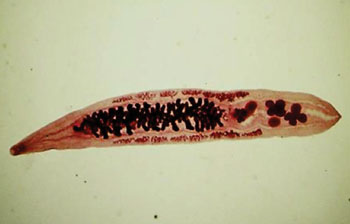Unsuspected Bacterial Link to Bile Duct Cancer Discovered
By LabMedica International staff writers
Posted on 06 Jul 2016
Bacteria in the bile duct have been identified as a potential risk factor in the development of bile duct cancer, or Cholangiocarcinoma, a rare but aggressive form of cancer with symptoms that do not present themselves at the early stages.Posted on 06 Jul 2016
Cholangiocarcinoma (CCA) is associated with multiple risk factors that are geographically distinct; choledocal cysts and primary sclerosing cholangitis have been implicated in the development of CCA in Western populations, while infections by the liver fluke parasite have resulted in higher incidence of CCA in Southeast Asia.

Image: An adult Opisthorchis viverrini or Southeast Asian liver fluke stained with carmine (Photo courtesy of the CDC).
An international team of scientists working with The Agency for Science, Technology and Research (Singapore) profiled 60 primary CCA tumors and matched normals, from both 28 liver fluke (Opisthorchis viverrini) associated (Ova) and 32 non-O. viverrini associated (non-OVa) cancers, using high-throughput 16S rRNA sequencing.
Agencourt AMPure XP (Beckman Coulter, Brea, CA, USA) was used to purify the amplified products and purified products were visualized using Agilent Bioanalyzer, prepared with Agilent High Sensitivity DNA Kit (Agilent Technologies, Waldbronn, Germany). As controls for assay specificity, 16S rRNA polymerase chain reaction (PCR) was performed with extraction controls and the absence of amplification products was confirmed using Agilent Bioanalyzer.
The team discovered that bile duct tissue harbored a community of diverse bacteria species. Stenotrophomonas species, previously implicated in bile duct infections, were found to be preferentially dwelling in tumor tissue compared to normal tissue of non-fluke-infected CCA patients, highlighting their potential role in development of CCA.
In comparison to non-fluke-infected CCA tissues, fluke-infected CCA tissues were found to contain enteric bacteria whose metabolic outputs, bile acids and ammonia, have been previously linked to carcinogenesis, or the formation of cancers. Taken together, the results suggest a role for bile duct tissue microbiome in development of CCA and which may accordingly be used as a target for therapy.
Niranjan Nagarajan, PhD, the co-senior author of the study, said, “Until recently, our understanding of bacterial communities resident in our body and their association with diseases has been limited. The associations detected in this study provide a smoking gun for the role of bacteria in bile duct cancer, and we hope that this discovery will accelerate our search for a cure for cholangiocarcinoma.” The study was published in the June 2016 issue of the journal EbioMedicine.
Related Links:
The Agency for Science, Technology and Research
Beckman Coulter
Agilent Technologies














